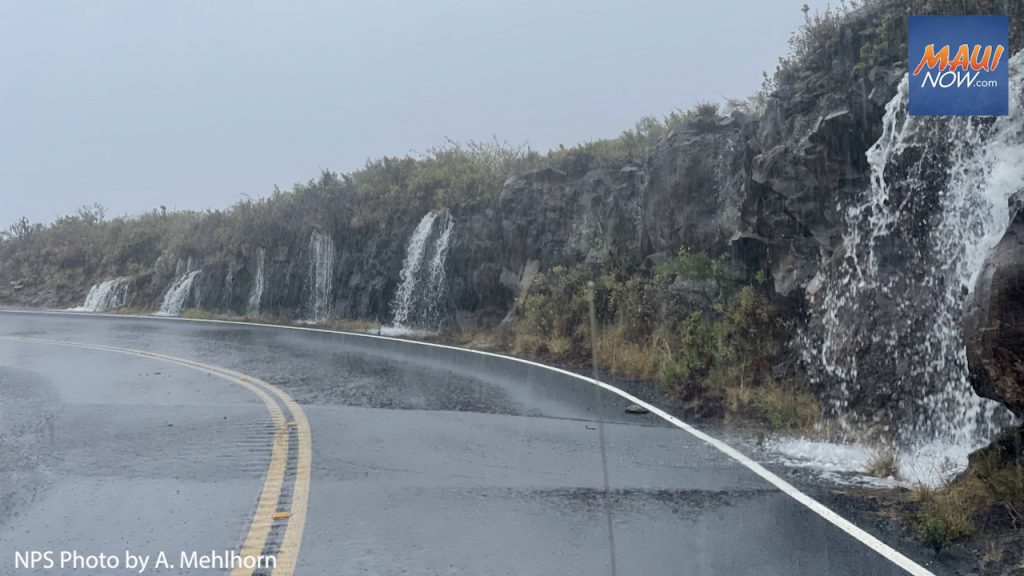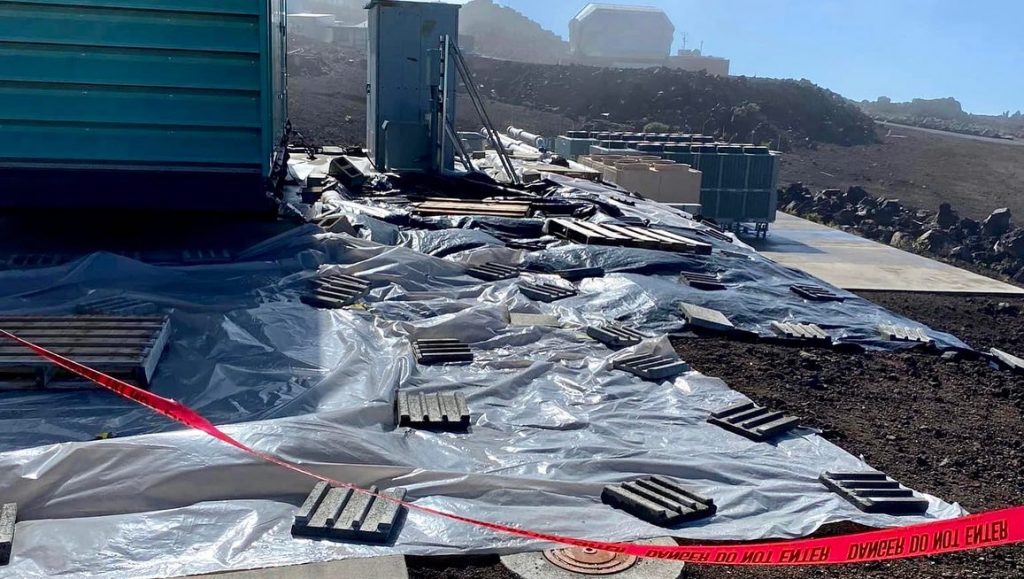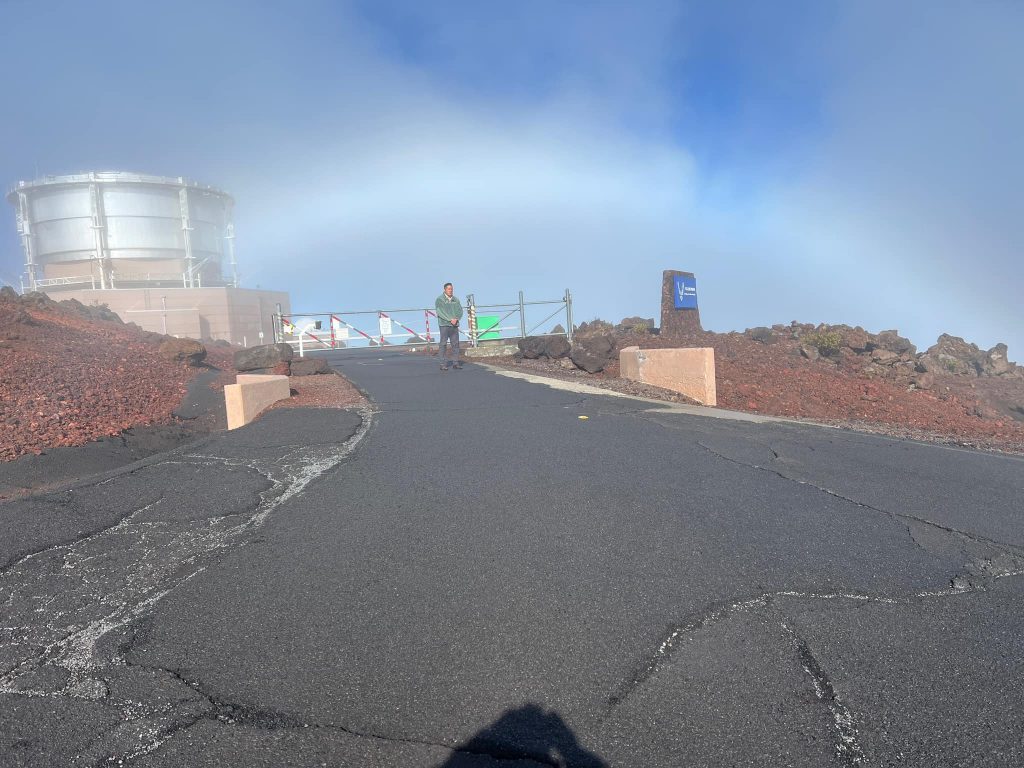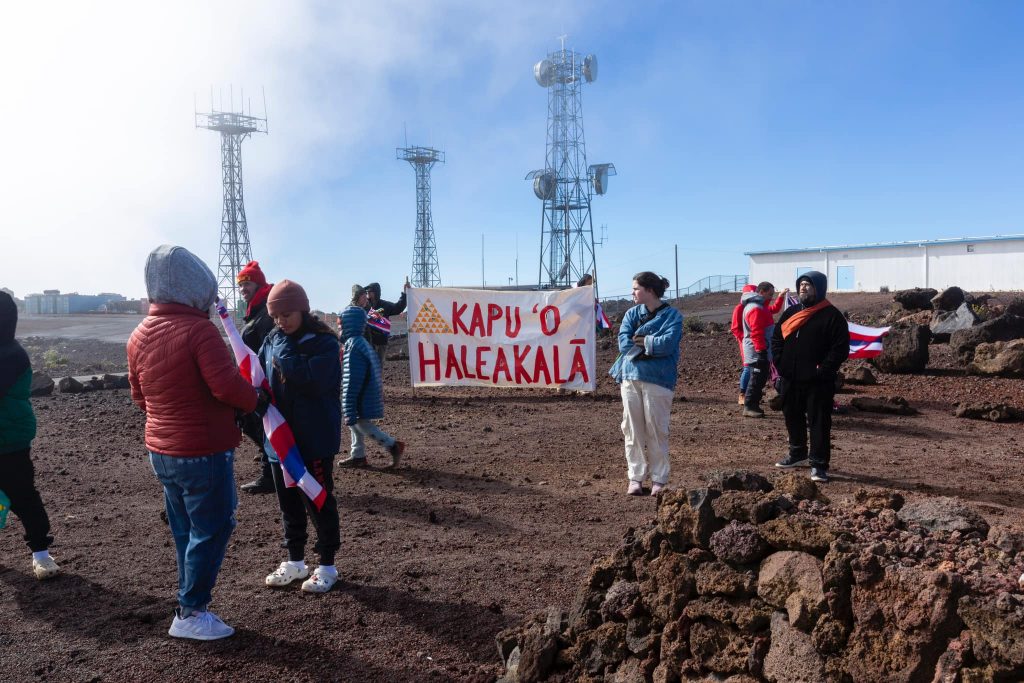Power surge likely a contributing factor to fuel spill at Haleakalā, official expresses remorse
VC: US Air Forces / DMA Pacific – Hawaii Media Bureau
The US Pacific Air Forces provided an update to the public on remediation plans amid criticism after 700 gallons of diesel fuel spilled at the Maui Space Surveillance Complex Sunday, Jan. 29 into Monday, Jan. 30, 2023.
Brigadier General Anthony Mastalir, commander of the US Space Forces Indo-Pacific, said equipment failed in a “catastrophic way,” and said a power surge during severe weather reported last weekend, was a likely contributing factor.
He spoke at a press briefing at the summit, apologizing for spill and vowing to deliver information with transparency.
“Words cannot describe the tremendous remorse that I and the rest of the team here at the Summit have experienced over this past week. We have a solemn responsibility to protect this sacred ground upon which we have the privilege to operate–and it is a privilege, not a right,” he said. “You expect more from us, and last week we let you down–and for that I am truly sorry.”

700 gallon estimate is a “worst case scenario”
On the evening of Sunday, Jan. 29, approximately 700 gallons of diesel fuel spilled at the Maui Space Surveillance Complex.
The size of the spill was described as “a simple calculation” based on known factors, including the amount of fuel in the generator tank, the rate of consumption, and how much available fuel there was in the storage tank.
The 700 gallon estimate was described as a “worst case scenario.” “It may be less than that. We assumed that the main generator tank was a the lowest possible point. In other words, if the main generator tank was filled to a different level than our assumption, the actual spill may have been less. Right now it is not more than 700 gallons. We are certain of that,” said Brig. Gen. Mastalir.
Equipment failed in a “catastrophic” way
After examining the the generator equipment, the Air Force made an initial determination.
ARTICLE CONTINUES BELOW AD“We currently assess that the cause of this spill was a damaged float within the generator’s main fuel tank. Specifically, the evidence suggests that a power surge was the likely cause of this damage. Additional analysis is ongoing to better understand exactly why this float failed in the on position.”
–Brig. Gen. Mastalir
“We’re going to continue to look through and better understand exactly why this equipment failed in such a catastrophic way, as opposed to failing in a safe way, which is the way that it was designed,” he said.
In explaining the mechanics, Brig Gen. Mastalir said, the float rests on top of the fuel similar to the float in a toilet that you have in a residential home.
“So when the fuel drops to a certain level, the float is designed to call for more fuel, and the transfer pump moves fuel from the storage tank into the generators main tank. As the fuel in that main tank rises, the float should then send a signal to the transfer pump to turn off. If for some reason that pump does not turn off and the float continues to rise, it is designed to then send an alarm so that we notify individuals that there is a potential overflow situation,” he said.
“This float failed in a way that none of those signals were sent. So the transfer pump continued to bring fuel from the storage tank into the generator’s main tank. And then overnight, it began to overflow and seep down under the sides of the concrete pad,” according to his description.
The spill site consists of a green teal Conex container that houses a diesel generator within. Below the generator is its fuel tank. A white structure adjacent to the container is the site of the storage tank.
“There’s absolutely no issues with our storage tank. The problem again was inside of that generator fuel tank,” said Brig. Gen. Mastalir.
A tarp covered the area where the fuel, on either side of a concrete slab, seeped off the slab and into the soil.
Preliminary analysis: A power surge during inhospitable weather likely damaged the generator’s float

Air Force officials said day to day the operations that take place at the Maui Space Surveillance Center, operate on commercial power.
“We have a HECO substation just around the corner. But when we lose commercial power, for example, due to a powerful lightning storm–which occurred last weekend–the generators are the backup source to preserve operations,” said Brig. Gen. Mastalir.
Officials on Monday said the generator is still being used a week after the spill; however, the Air Force is actuating the transfer pump manually.
“So we are not allowing that transfer pump to operate unless somebody is standing right next to it. There’s an easy way to do that–you close the valves, and you open the circuit breakers to it. Without power and with the valves closed, there’s no way for that transfer pump to move fuel. So it’s only used to continue to bring fuel in, but it’s now a manual process until we can have things repaired and inspected, and ensure that the safety protocols that we need to achieve are met,” said Brig. Gen. Mastalir.
“Last weekend, it was pretty inhospitable weather here on the summit. Severe rain, high winds, numerous, numerous lightning strikes–so all of that contributed… as we go through this analysis and we look through the evidence, it all contributes to this conclusion that a power surge is likely what caused the damage to this float.”
–Brig. Gen. Mastalir
Question over delayed report to the public
The spill happened overnight on Sunday, Jan. 29, but the public was notified approximately two days later on Tuesday evening, Jan. 31. During a Spotlight Hawaiʻi interview with the Honolulu Star-Advertiser on Friday, Maui Mayor Richard Bissen said he was also notified on Jan. 31 as well.
Maui Now asked Brig. Gen. Mastalir to explain the reasoning behind this. He responded in an email communication saying:
“My priority was to gather all available facts on the situation including any health and safety risks to our local communities. We notified the Maui Fire Department within five minutes and the Department of Health within a few hours of discovering the fuel leak. I chose to personally and individually notify local and state leaders of the incident, after which we notified the public. We take environmentally hazardous leaks – no matter how severe – very seriously and will thoroughly review this incident.”
He said Governor Josh Green was notified of the mishap “in the hours after” the Air Force learned of the spill.
What remediation looks like:

Moving forward, Air Force officials say they are focused on a “thorough and complete” remediation process at Haleakalā.
Brig. Gen. Mastalir outlined principles he planned to use in guiding this effort. He said he would:
- Promote openness and full transparency throughout the process;
- Develop a remediation plan that is consistent with legal requirements and sensitive to the local and cultural imperatives; and
- Work everyday throughout this process and thereafter to rebuild the public trust.
“Industry standard remediation processes and protocols are not sufficient for this sacred ground. We have to go above and beyond what would otherwise be deemed acceptable. And that is what we are going to do,” said Brig. Gen. Mastalir.
When asked what details the remediation involves, he said he would be sharing information throughout the process with the others operating at Haleakalā and across the Air Force and with the Department of Defense.
Experts will look at a number of modifications to improve the capability of containing a potential spill, according to the agency.
“The initial plan will be to remediate to 200 cubic yards around the generator. That is a depth of about 6 feet. At that point, we will take measurements to better understand what that level of contamination is. It’s impossible to know at this point, exactly how deep the diesel fuel has saturated into the topography.”
–Brig. Gen. Mastalir
Once remediation and excavation have occurred, the team will then work to analyze what’s required to measure the level of contaminant, and if necessary, continue to proceed.
“Right now, it’s impossible to know exactly how deep we will have to go,” he said.
Mayor seeks accountability

Mayor Richard Bissen, Jr. visited the site Thursday where he received an overview of the incident. He said the sacredness of Haleakalā cannot be minimized and that the reverence of this wahi pana requires respectful, thorough and complete attention.
In an interview with the Honolulu-Star Advertiser, he emphasized the need for transparency and accountability. He described the current atmosphere as a “post-Red-Hill climate,” where there is a heightened awareness of what could happen, while also acknowledging a difference in the location, quantity and impact of the spill on Maui.
Brig. Gen. Mastalir said his message to the mayor was simple: “I said mayor, hold us accountable if we don’t live up to the principles that we have outlined. He assured me he would, and I think you’ve heard him say that publicly over the past week,” said Brig. Gen. Mastalir.
Group calls for no lease renewal
The Hawaiian rights group, Kākoʻo Haleakalā, said the spill incident on Maui constituted an “abuse of ʻāina” and showcased a “lack of human decency” toward Hawai’i’s sacred places, natural resources and its people.
The group launched a Change.org petition against lease renewal at the site saying, “The recent contamination incident at Haleakalā is yet another example of the US military’s detrimental impact on Hawai’i’s sacred places, natural resources and people.”
As of Feb. 7, the document had garnered 342 signatures.
Members of the group have been vocal opponents of the construction of both the Daniel K Inouye Solar Telescope on Maui and the Thirty Meter Telescope on Hawaiʻi Island, staging demonstrations during planning and construction convoys dating back to 2015.
Earlier this week the Air Force engaged in discussion with Kakoʻo o Haleakalā, Friends of Haleakalā, and Kilakila o Haleakalā.
“My message to this group was simple–we want you to be part of this process,” said Brig. Gen. Mastalir. “At the same time, we will continue to increase our safety protocols and do everything we can to ensure that something like this never happens again.”
Brig. Gen. Mastalir said he Air Force would affect a higher level of safety analysis than would otherwise be called for.
“When it comes to remediation, we will absolutely take into account and we welcome these Native Hawaiian organizations to provide and help with cultural monitoring and to help walk us through every step of the way to ensure that we not only meet what is legally required by industry standards and by the local regulatory authorities, but that we meet the requirements of these local organizations in terms of that local customs and the imperatives of working and operating on a sacred ground,” he said.
What does transparency look like?
When asked what transparency looks like, Brig. Gen. Mastalir said:
“To me transparency means when I learn of more information, I’m going to bring it and share it with all of you. We’re going to be completely open as we go through this process. There is absolutely no reason not to be. We absolutely understand the cultural imperatives here at Haleakalā. We are respectful of that and we are committed to complete openness and transparency throughout–sharing information as it becomes available to us,” he said.
“I can’t emphasize enough–just meeting the minimum requirements is not sufficient here–not for Haleakalā. We have to really aim higher–and we’re going to,” he said.
The incident was met with concern from state lawmakers who represent Maui and released statements after learning of the news:
- Senator Lynn DeCoite (District 7 – Hāna, East and Upcountry Maui, Molokaʻi, Lānaʻi, Kahoʻolawe, and Molokini) called the spill “completely unacceptable,” and “very concerning” for those who work and live near the summit.
- House Representative Kyle Yamashita (D-12, Upcountry) called the spill “deeply troubling,” and said he would work with state and federal regulators to monitor the situation and hold the responsible parties accountable.
- Representative Mahina Poepoe (D-13, Moloka‘i, Lāna‘i, Kaho‘olawe, portion of Kahului, Ha‘ikū, Pe‘ahi, Huelo, Nāhiku, Hāna, Kīpahulu) said she was “greatly alarmed” by the incident.

Team of experts assembled to begin remediation
Brig. Gen. Mastalir said a team of experts was pulled from across the Air Force, and has been assembled to begin the remediation process.
Experts include: Colonel Michal D. Holliday, the Commander, Detachment 2, Air Force Installation and Mission Support Center, Joint Base Pearl Harbor-Hickam, Hawaiʻi; Archaeologist Valerie Curtis; Angelia Binder, natural resources/water quality and spill specialist; Sr. Master Sgt. Damon Ingram, Master Electrician; Master Sgt. Craig Stawicki from the 647th Civil Engineering Squadron at Joint Base Pearl Harbor-Hickam; Lt. Col. Phillip Wagenbach, Commander of the 15th Surveillance Squadron and his executive director, Mr. Richard Chong. Additionally, an Environmental Remediation Project Manager from the Air Force Civil Engineering Center; and an Electrical Engineer with the Air Force Installation and Mission Support Center will serve on the team.
Likewise, the Air Force is looking at a number of vendors to support their remediation effort, and is gaging their level of experience in working specifically with the remediation techniques that will be called for at Haleakalā.



















